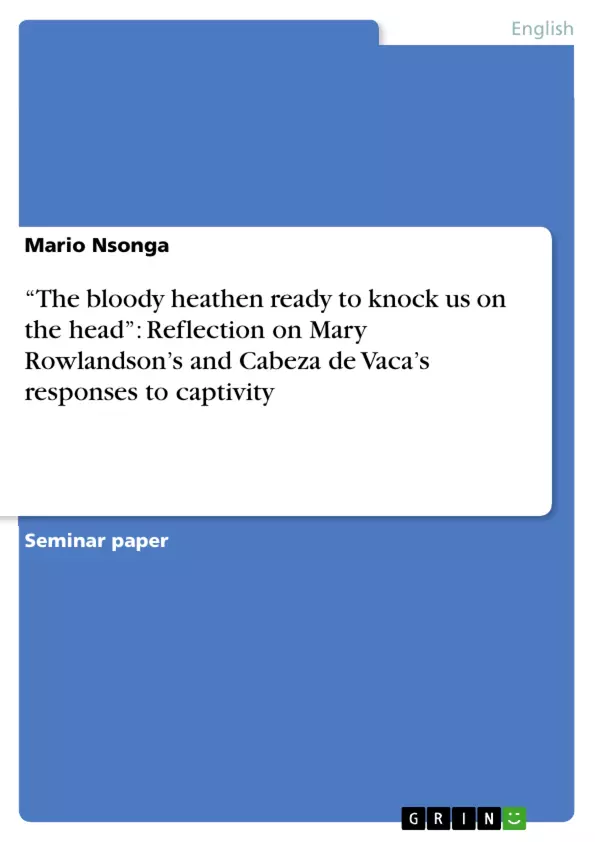Inspired by medieval accounts about the City of Gold and the opportunity to tie on the famous Spanish conquerors, Cabeza de Vaca enthusiastically embarks to the Americas in 1527. However, the so-called Narváez Expedition develops different than expected and turns into a total disaster: during their expedition along the west-coast of Florida, Cabeza and his crew get lost, the majority of his comrades dies and Cabeza falls into the hands of the Indians. Exactly one century later, the Puritan goodwife Mary Rowlandson meets a similar fate and – after her town Lancaster has been raided by the Indians – becomes an Indian captive as well. This paper will extrapolate the different approaches of Vaca and Rowlandson to their Indian captivity, exemplifying through them the diverging intentions and strategies of the major colonizers of the New World, namely the English and Spanish. Therefore, I will mainly concentrate on Mary Rowlandson’s account, accentuating her Puritan creed and the ambivalent success of her adaption of those principles on her life during captivity. In doing so, this paper will provide the reader with a brief historic overview about the Puritans’ religious agenda in New England and explain why Rowlandson’s text was met with such an exorbitant approval. In a short excursion, the main differences and similarities between Rowlandson’s and Vaca’s narration will be highlighted, only to point out that both Rowlandson and Vaca were figures bound to the social, cultural and religious conventions of their time.
Inhaltsverzeichnis (Table of Contents)
- Introduction
- The Relevance of Rowlandson's Account for Puritan Society
- Rowlandson's Implementation of Puritan Principles
- Similarities between Puritans and Indians
- Short Excursion: Rowlandson vs. Cabeza de Vaca
- Conclusion
Zielsetzung und Themenschwerpunkte (Objectives and Key Themes)
This paper explores the different approaches of Cabeza de Vaca and Mary Rowlandson to their experiences as Indian captives, highlighting the diverging intentions and strategies of the English and Spanish colonizers of the New World. The main focus is on Mary Rowlandson's account, analyzing her Puritan beliefs and how she adapted them to her life in captivity.
- The impact of Mary Rowlandson's narrative on Puritan society
- The role of Puritan principles in Rowlandson's captivity experience
- The similarities and differences between Rowlandson's and Cabeza de Vaca's accounts
- The historical context of Puritan colonization and its influence on Rowlandson's narrative
- The cultural and religious conventions of the 17th century and their impact on captivity narratives
Zusammenfassung der Kapitel (Chapter Summaries)
Introduction: The paper introduces the central theme of captivity narratives, focusing on the experiences of Mary Rowlandson and Cabeza de Vaca. It outlines the historical context and the main objective of the analysis, which is to understand the differing approaches to captivity experienced by these two figures.
The Relevance of Rowlandson's Account for Puritan Society: This section examines the significance of Rowlandson's narrative for Puritan society. It discusses how her account broke with traditional patriarchal structures and established a new genre of "Indian captivity" narratives. The section also analyzes the Puritan context and the reasons behind the narrative's popularity, highlighting the anxieties and concerns prevalent within Puritan communities at the time.
Rowlandson's Implementation of Puritan Principles: This chapter explores how Rowlandson's Puritan beliefs guided her actions and thoughts during her captivity. It examines the ways in which she interpreted her experiences through the lens of her faith, demonstrating her resilience and adaptability within the context of a hostile environment.
Similarities between Puritans and Indians: This chapter delves into the surprising similarities between Puritan and Native American cultures and beliefs. It examines the shared experiences and values, highlighting the complex and nuanced relationships between these two groups.
Short Excursion: Rowlandson vs. Cabeza de Vaca: This section provides a brief comparison between Rowlandson's and Cabeza de Vaca's narratives, drawing attention to the distinct approaches and interpretations of their respective experiences. It explores the cultural, religious, and societal differences that influenced their perspectives on captivity.
Schlüsselwörter (Keywords)
The primary focus of this text is on the captivity narratives of Mary Rowlandson and Cabeza de Vaca, analyzing the motivations and strategies of the English and Spanish colonizers. It explores the role of Puritan principles in Rowlandson's experience, highlighting the impact of her narrative on Puritan society. Key themes include captivity narratives, Puritanism, cultural adaptation, religious beliefs, colonial expansion, and the intersection of cultural identities.
- Citar trabajo
- Mario Nsonga (Autor), 2012, “The bloody heathen ready to knock us on the head”: Reflection on Mary Rowlandson’s and Cabeza de Vaca’s responses to captivity, Múnich, GRIN Verlag, https://www.grin.com/document/207837



